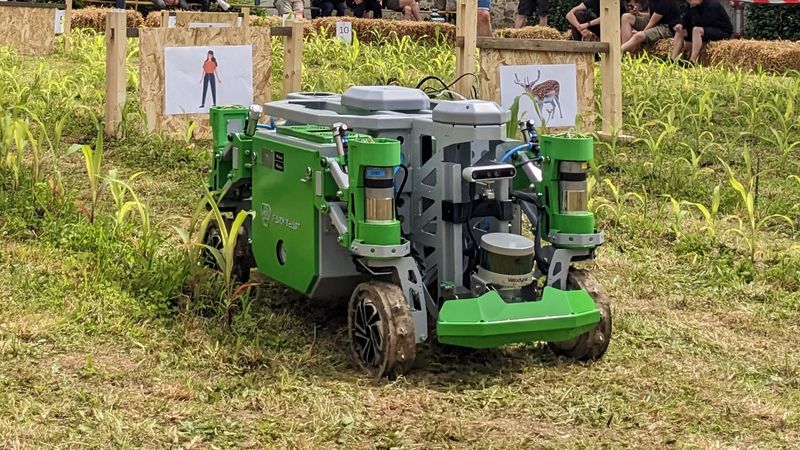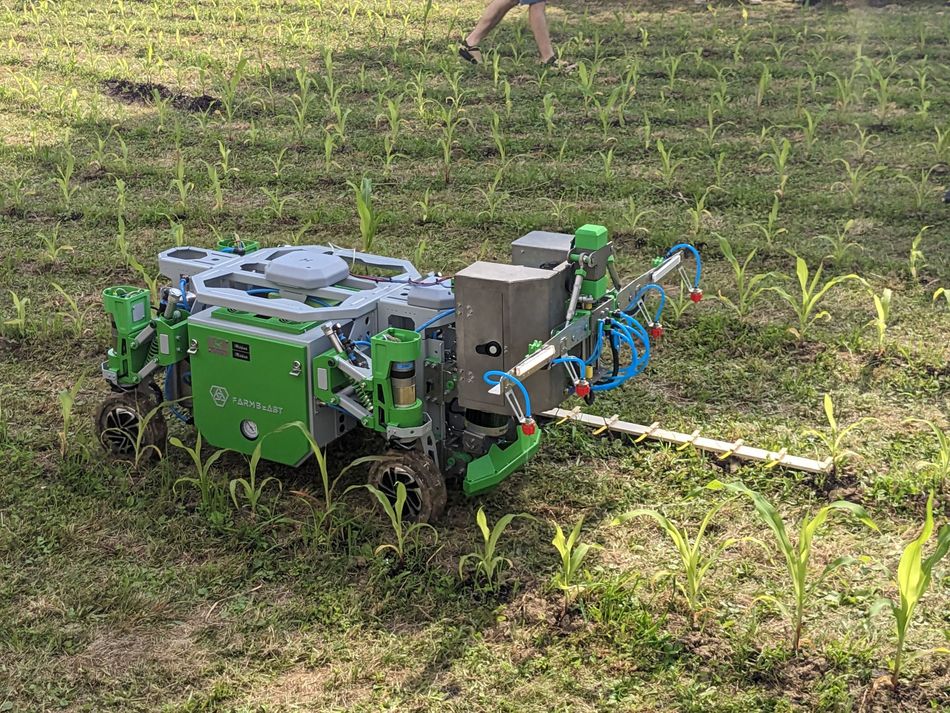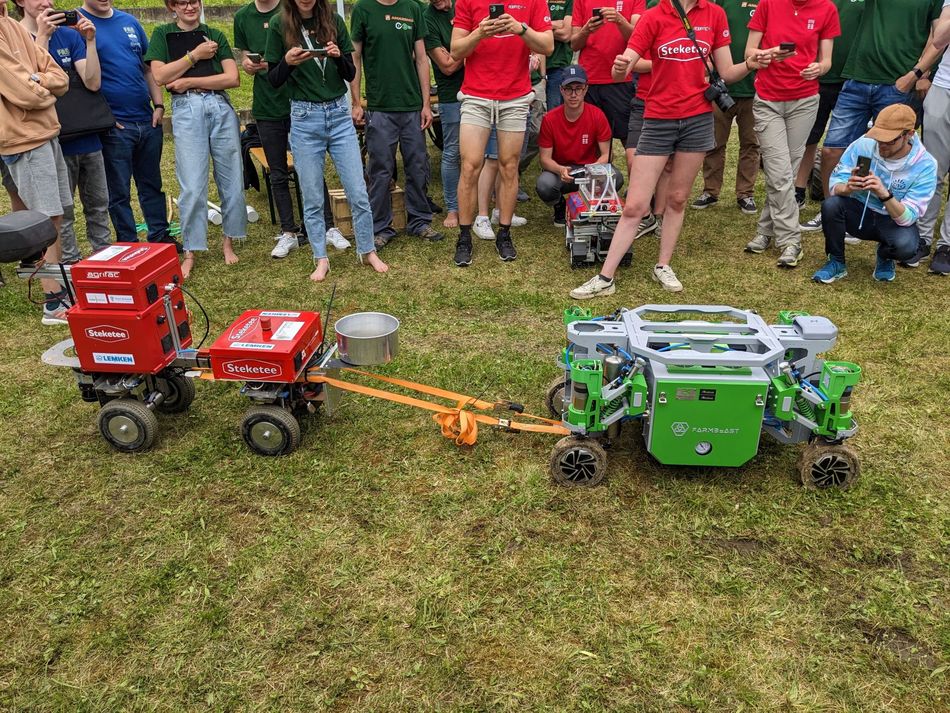OKdo ROCK Challenge: Interview with Urban Kenda. Precision robotic farming
In response to the OKDo Engineering Challenge provocation, a team from the University of Maribor submitted a proposal to use the ROCK 5B in their raspberry detection and localization robot.
The ROCK Engineering Challenge invited engineers, entrepreneurs, inventors, and developers to submit an idea for a part, product, or system that took advantage of the ROCK single-board computers. The challenge received a significant number of submissions from across the globe, impressing the judging panel with cutting-edge applications of single-board computers. In a new series, we are speaking with entrants from the challenge to learn more about their innovative ideas. In our latest interview, we spoke to Urban Kenda who has been working on a robotic farming project with fellow students from the University of Maribor in Slovenia.
Wevolver writer, Lori Baldwin, spoke with Urban about the collaborative nature of the project and how SBCs are enabling near, real-time detection and localization.
Lori Baldwin: Can you start by telling us about yourself and the project you're working on?
Urban Kenda: My name is Urban, and I come from Maribor, Slovenia, where I attended the University of Maribor. I've been part of a farm-based project, a team working on a robot for the past four years. I've been leading the team, but I'm gradually transitioning to a new project as I've now completed my Masters.
The farm-based robot project involves students from various courses, including engineering, programming, and agriculture. This diverse team allows us to address problems more effectively. The project began in 2008 when the current professor, who is now our mentor, was a student working on it. Over the years, the robot has undergone several updates, with each iteration introducing new features and improvements. The robot has two main objectives: to compete in field robot events and to make farming more efficient by automating manual tasks. This year, our focus was on automating raspberry picking due to the challenges involved in harvesting raspberries without damaging them.
Lori Baldwin: What was your role in the project?
Urban Kenda: My primary role was focused on the detection and localization of raspberries. I also served as the team captain.
Lori Baldwin: So, you applied for the OKdo competition with your robot; how have you incorporated SBCs?
Urban Kenda: We've integrated SBCs into the robot, especially for raspberry detection and localization. To detect raspberries, we use an algorithm that employs neural networks, requiring substantial computational power. Additionally, we need to transform 2D camera images into 3D point clouds, which also demands computing power. However, since we aim to keep everything on our robot, we needed small, robust, and powerful SBCs, which served our needs well.
Lori Baldwin: What are some of the benefits you see in the ROCK series of SBCs?
Urban Kenda: The team is in need of a powerful computing device, such as the ROCK 5B 16GB, to support their current work and future research. This device will be utilized to process data from various sensors and calculate the best path for the autonomous field robot. Furthermore, the team plans to use it for their upcoming research on using a YOLO neural network to detect raspberries and a robotic arm with an original origami gripper design to pick them. In summary, the ROCK 5B 16GB will greatly enhance the team's ability to perform their current and future research.
The main advantage of using SBCs was that they made the entire system faster. While it's not real-time detection, it's sufficiently fast for our robot, which moves at a slow pace. In comparison, using traditional PCs for detection led to much slower processing, with one detection occurring every five seconds. So speed and efficiency were the primary advantages.
Lori Baldwin: How long did it take to have a working system?
Urban Kenda: The development process had its ups and downs. We received the ROCK SBC in March or April, and by June, we had tested the system and considered it functional. However, there was ongoing fine-tuning, optimization, and addressing minor issues, which is typical in such projects. So, the most time-consuming part was the continuous refinement and improvement of the system.
Lori Baldwin: And have you succeeded in developing a raspberry-picking robot?
Urban Kenda: To be honest, we haven't fully succeeded in developing a robot that can pick raspberries. We've made progress in different sections, and each part has been successful in its own right. However, integrating all these components into a functional robot has proven to be a more significant challenge, taking an additional year or two. It's more of a proof of concept at this stage.
Lori Baldwin: Let's talk about the primary challenge the robot was built to address. Can you tell us more about it?
Urban Kenda: Certainly. Our robot was designed for the Field Robot Event competition, where it faces several tasks. The first two tasks involve row navigation in a field of corn, requiring the robot to navigate the rows and handle obstacles. The third and fourth tasks involve camera-based detection, where our SBCs were crucial. This year, we had to detect objects like humans and deer and take appropriate actions. The fifth task, known as "freestyle," allows teams to work on farm-related ideas. This year, our focus was on raspberry picking, though we couldn't compete due to incomplete development.
Lori Baldwin: I hope you can compete in the future. Can you also tell us about the challenge related to raspberry picking?
Urban Kenda: Yes, of course. Raspberry picking involves several stages, and we divided it into three main parts. First is raspberry detection and localization, which was my area of focus. We used two types of sensors, an RGB camera and a LiDAR sensor to detect raspberries in 3D space. The LiDAR provided precise point cloud data. For robot arm control, we initially used a 3D printed arm but later switched to an industrial arm. We faced challenges in planning the arm's approach to raspberries. Finally, we developed a soft gripper inspired by Japanese origami, which allows for delicate and damage-free picking. This approach showed promise and offered an innovative solution to raspberry harvesting.
Lori Baldwin: Outside of the competition, how can this technology benefit the agricultural sector?
Urban Kenda: Beyond the competition, our robot has the potential to automate and reduce the manual labor required in farming. It offers the advantage of working continuously and can handle tasks that are physically demanding for human farmers. However, we've encountered resistance from traditional farmers who prefer established methods. Younger farmers tend to understand the benefits of automation and are more open to these technologies.
Lori Baldwin: Have you received any feedback from farmers regarding the raspberry picking robot?
Urban Kenda: While testing, we received feedback from farmers, and while they acknowledged the potential of our technology, they expressed concern about the pace of development. Farmers are understandably eager for end products and often reluctant to wait for technology to mature. However, the agriculture sector is gradually evolving, and younger farmers tend to be more receptive to adopting such technologies.
Lori Baldwin: What initially sparked your interest in agricultural robotics?
Urban Kenda: I became interested in agricultural robotics because I noticed that many industries, like automotive and manufacturing, had advanced significantly with the use of robotics. However, the field of agriculture seemed to lag behind. I saw an opportunity to bring technological innovation to this sector, and I find it both fun and challenging to work in this domain. It's a dynamic field with unique problems to solve.
Lori Baldwin: How do you see SBCs playing a role in the future of agricultural robotics, and how can they be integrated further?
Urban Kenda: I believe that in the future, agricultural robotics will benefit from a more decentralized approach, with smaller and more diversified single-board computers (SBCs) handling specific tasks. Instead of relying on a central computer, having SBCs with their own functions can lead to a more efficient and adaptable system. Each component of a farm can have its own SBC, such as a sprayer, a tractor, or a robot, making the entire system smarter and more agile.
Read more about how SBC’s are enabling precision agriculture here.



